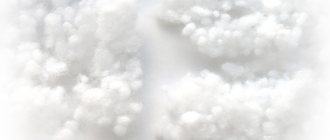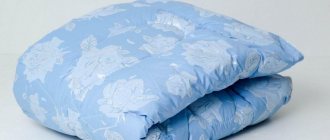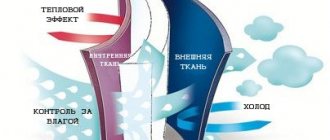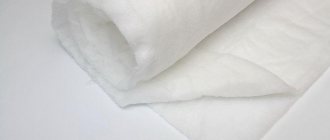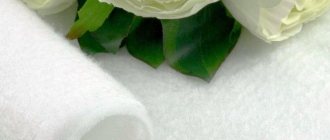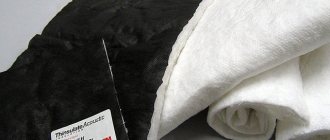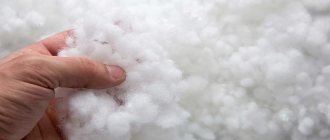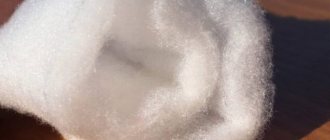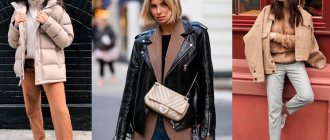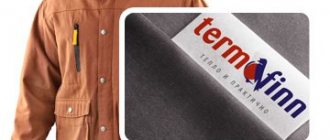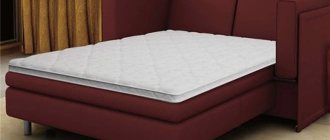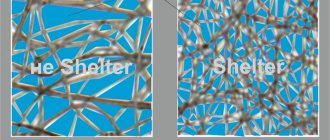A long time ago, overalls for children were stuffed with one or two insulating materials. Basically, children wore fur coats and “didn’t show off.” Everything is changing, our life has become more intense, faster, brighter. It requires a sporty attitude towards walks: the child is not just exposed to the street to breathe like a houseplant, it pretends to be active and have an eco-friendly existence inside its clothes.
Manufacturers of sports and travel clothing use a variety of synthetic materials as insulation. Almost all of them came from synthetic padding polyester. It has been experimentally established that jackets and sleeping bags made of thick synthetic padding quickly deteriorate: they clump when washed, do not keep warm, and the body in them, as a tourist or athlete would like, does not breathe, but fogs up. Sintepon conducts air poorly and retains heat poorly.
New insulation materials have appeared: holofiber, Thinsulate, Fibertek... And clothes for children have appeared that use these insulation materials. What to prefer? What will a child wear for sure and definitely not freeze? The advantage of synthetic insulation is that they are hypoallergenic, they do not harbor microorganisms (mites, etc.), and clothes with various “fibers” (“fiber” is translated as “fiber”) inside hold their shape better and do not deform from washing, Keeps you warm and doesn't let cold air in.
So, let's deal with insulation without going into highly scientific jungle. Let's consider aspects that are interesting to the average consumer who wants to dress their child comfortably.
Rule number one!
Don't be impressed by an obscure name. The manufacturer, trying to capture the attention of the consumer, comes up with its own (trade) names for insulation materials. You need to carefully look at the label on the clothing itself. It shows what materials were used for the outer fabric, lining and padding. Don’t be surprised if you see the inscription: “insulation – polyester 100%”. And where, you know, is that “fiberskin” or “polyfiber”? Polyester is an illiterate reading of the English word polyether (polyester). In our country the name “lavsan” is accepted. Almost any synthetic insulation consists of polyester fibers. Thus, on the label you will read what the material for the insulation is made of, and more detailed instructions or a sales consultant should tell you what the name of the insulation itself is, what technology it is made of, and what this technology provides. Products from reputable companies have a special booklet where all the materials are described in detail and their qualities are indicated.
Rule number two!
Indicate strict preferences in choosing clothes and remember what it is like for your child outside in winter (not for you or his grandmother, but for him). Is everything good with his thermoregulation? Is there such a thing as cold feet syndrome? How often does it get cold? 80% of childhood colds are not to blame for the immune system, but for parents who do not know how to dress their child. As the classic said: there is no bad weather, but there are poorly dressed people, in the case of children - incorrectly dressed. For example, a child who often suffers from colds should never be re-wrapped, and it is absolutely forbidden to wear thick hats and tie tight scarves. I will catch colds even more often. Not a single seller will be able to explain to you whether your child will freeze in just such clothes. All new generation synthetic fillers work on the same principle: they retain heat well. Look for (ask) an indicator of the permissible temperature (up to -10° or up to -40°).
Rule three and most important!
Remember that it is not the insulation that heats, but the air in its cavities. The lighter the fibers, the more cavities inside, the lower the temperature at which these clothes can be used. The best thermal insulator is air.
The label on a real down jacket should say “down”. This means that the fluff inside is eider, swan or goose. 100% “down” is quite rare. Most often, feathers are added to it and written “feather”. If the label says “cotton”, this is not a down jacket, but just a lined jacket. The inscription “wool” indicates that there is wool batting inside this jacket, and the word “polyester” or “waltern” refers to padding polyester or its modern varieties.
Features and characteristics of thermofiber filler
Thermofiber is a modern insulation material made from polyester fibers. Non-woven material consists of twisted fibers impregnated with silicone. Thanks to the peculiarities of manufacturing technology, it has elasticity, does not bunch up and is not deformed. Find out about curtains on one side for a bedroom window here.
The single fabric has high thermal performance, is elastic and does not absorb moisture.
There are two types:
- Spiral or thermal fiber - practically does not wrinkle, restores well and keeps its shape, used in the manufacture of blankets, mattresses and clothing.
- Ball - often used for filling souvenirs and soft toys.
Composition: what is it made from?
It is a biologically based insulation material. The non-woven fabric has a spherical three-dimensional structure, the basis for which was taken from natural swan down. Consists of polyester threads coated with silicone. Unlike other synthetic insulation materials, thermofiber contains no adhesive emulsions at all. This ensures environmental safety. Read how to choose a baptismal set for a girl here.
Environmentally friendly material that does not cause allergies and does not emit harmful substances. Thanks to its unique composition, the fabric can be used for sewing outerwear and home textiles for children.
Depending on the raw material component, there are 2 grades:
- Primary polyethylene terephthalate.
- Recycled PET.
What properties does it have?
Dries quickly, does not absorb moisture and practically does not get wet. It has ventilation properties and breathes well.
Thanks to its density, it can withstand wind gusts of up to 15 m/s.
Also, synthetic insulation has the following characteristics:
- hypoallergenic;
- high level thermal insulation;
- air exchange and thermoregulation.
Up to how many degrees is the insulation, for what temperature and weather
The cavities inside the fibers increase the thermal insulation qualities of the fabric. Thanks to its good breathability, thermofiber ensures free evaporation of moisture and retains heat. Can withstand frost and provide comfortable warmth down to -35°C.
Unlike synthetic padding polyester and buret silk, the diameter of thermofiber fibers is approximately 1/3 larger. This feature allows you to reduce the weight of the material with the same thickness of the web. The insulation hardly gets wet during rain and can withstand strong gusts of wind. Agatsib Novosibirsk will tell you about knitwear in this material.
Advantages and disadvantages
Each type of insulation has both pros and cons. Compared to other synthetic materials, thermofiber has a wide range of applications. It is used for tailoring, home textiles, outerwear and in construction.
Benefits include:
- increased moisture resistance;
- high biostability;
- does not absorb odors and does not emit harmful substances;
- quick recovery of shape;
- durability;
- environmental friendliness;
- hypoallergenic;
- ease of care.
Disadvantages include the ability of the canvas to accumulate static electricity. In addition, it is easily flammable from open fire and is not resistant to high temperatures.
Production: how to get it
Highly siliconized polyester microfibers are used for production. The production technology consists of one procedure - special processing of fibers. Ultra-thin fibers are coated with a layer of silicone and twisted into spirals. The volumetric balls are springy and do not cake, retaining their original shape even after long-term use.
The nonwoven fiber manufacturing process uses a carding machine to card the webs. The threads are captured by the needles and stretched in different directions. The resulting air voids provide porosity and resistance to stress. Read about Belarusian plus size clothing in this article.
The canvas itself will acquire the character of a spring, capable of rapid recovery after tension or force.
Useful tips
Many modern insulation materials are capable of serving their owners for a long time without any problems. To significantly increase their service life, follow certain recommendations:
- Wash products containing down and other natural insulation materials no more than once per season. It is best to take them to dry cleaning.
- Washing jackets with padding polyester only by hand. This type of clothing should be dried away from heating devices and bright sunlight.
- They process things with holofiber, insulate, isosoft in the most gentle mode. If the product contains leather or other elements, you should entrust it to a specialist.
- All models with insulation are washed at low water temperatures (within 30-40 degrees), with a minimum number of revolutions. The spin is gentle, without intense movements. To dry, jackets, down jackets and other options are hung on hangers.
- If you want to change the color of the product, it is recommended to contact a professional. You can also dye clothes with filler yourself, but you will need to carefully follow all the rules and safety measures. If they are violated, the item risks being hopelessly damaged.
Varieties
May have several types. All varieties are made from polyester fibers and differ only in density and thickness. Depending on the thickness and length of the thread, thermofiber is divided into:
- Soft. The material is soft, light and very closely resembles natural down. It is universal and can be used in various areas where insulation is necessary. The thickness to length ratio is 7D/32.
- Hard. The ratio of fiber diameter to length is 15D/64. The canvas has good elasticity and quickly restores its original shape. Less elastic, therefore suitable for filling large parts.
- Vatu. In appearance, the water resembles natural cotton material. It is characterized by low density and low weight. Thin fibers are short in length, which ensures the airiness of the material. However, it is less durable than other varieties.
- Balloons. They are made from both hard and soft threads. Strongly twisted fibers are collected into small lumps-balls. The variety is characterized by an increased degree of elasticity and restoration of condition.
What is thermofiber?
Thermofiber is a new generation non-woven insulation. Its production is non-toxic, and the material itself is completely harmless to humans.
What distinguishes thermofiber and synthetic winterizer is, first of all, higher thermal insulation. The material is 30% warmer than its analogues.
The difference is also in the degree of moisture absorption: thermofiber absorbs liquid 10% less. In this indicator, it is superior to Isosoft and Thinsulate. Accordingly, clothes with it absorb less water when washed and dry faster.
To summarize, we can say that the material in question is warmer than synthetic padding and holds its shape better. It is distinguished from other high-tech materials by a lower degree of water absorption.
Scope of application: what to sew
Thermofiber of various densities and thicknesses is used in various fields. Due to its lightness and high level of thermal insulation ability, it is used to sew:
- Outerwear.
- Home textiles.
- Furniture covering.
It is used to make soft toys and souvenirs for children.
Use allows you to significantly reduce the weight and volume of the finished product, which is important when sewing outerwear. Find out about the knitwear catalog from Beloshveyka Raskazovo at this link.
Due to the hypoallergenic nature of the fibers, the material can be used for sewing toys and home textiles for children.
In mattresses
Bulky nonwoven fabric is often used to make mattresses and flooring. The fiber has a high level of compression, resembling the action of springs. This feature gives the mattress an additional orthopedic effect.
Durable and wear-resistant fabric with a density of 750-800 g/m2 has a long service life and has good heat transfer properties. The fibers ensure air circulation, making mattresses made from this material suitable for children and people with allergies and bronchial asthma. For people with an allergic reaction to certain types of fabric, clothes are also made from nettle.
Compound
Thermofiber is made from hollow polyester fibers. They are additionally treated with silicones.
The fabric is produced by heat setting. At the preparatory stage of production, the threads are combed using a special machine. Then exposed to elevated temperatures. After that, the canvas is given the required density on the winding unit.
The finished material minimizes fiber migration. It gains increased elasticity. The insulation does not cake and does not lose its original volume over time.
Recommendations for product care
It is recommended to store clothes in vacuum bags. When washing and ironing, adherence to temperature conditions is required. It is advisable to dry clothes made of twill and boucle material in a hanging position.
The insulation used in upholstered furniture is cleaned with specialized detergents.
How to wash in a washing machine
When using a machine for thermal fiber, eraser and artificial suede, the “delicate” mode is set (up to +90°C). If there is a special marking on the label, it is recommended to wash items with fine fiber filling by hand.
How to care for clothes.
Caring for jackets with thermal fire is very simple, because it does not shrink, does not wrinkle, and dries quickly. Since, in addition to insulation, the overalls contain outer fabric, lining, and fittings, the cleaning conditions are indicated on each product individually. After purchasing, be sure to keep the sewn-in tag with recommendations on the product itself. But what if there is no tag? Of course, you can follow the general principles of product care:
- ▶Washable in a drum-type washing machine at the lowest possible temperature,
- ▶Soaking with powder is acceptable at a temperature not exceeding 40 degrees,
- ▶It is recommended to use liquid washing gels: they do not accumulate in fabrics and are washed out in a few rinses,
- ▶Can be ironed when the iron is heated to 100 degrees,
- ▶It is advisable to dry in an upright position in a ventilated area to preserve the appearance and dry thoroughly.
Thermofiber jackets and sets are relatively inexpensive and have excellent thermal and performance characteristics. This filler is used by progressive companies - Alma-Tex (Alyusha), Lapland and others. The clothes are warm, comfortable and beautiful!
Video
Is it possible to wash thermal fiber in this video:
19.10.2016
Winter is coming, which means it's time to warm up. To make your choice easier, Children's Town has prepared a review of the fillings used by children's clothing manufacturers.
Natural fillers:
In down jackets and coats, the percentage of down and feather is very important. In a good down jacket it is from 60%/40% to 80%/20%, where the first number is the amount of down. There is no such thing as 100% fluff.
Down fibers are very mobile, which eliminates the possibility of down “climbing” to the surface. All seams on down clothing also undergo special treatment.
It is also necessary to take into account that down is an allergen and an excellent breeding ground for mites, so its antibacterial treatment is very important. Also, one of the main disadvantages of down is its ability to absorb moisture and certain difficulties when washing.
Advantages and disadvantages
Consumers value thermofiber filler for its high thermal insulation. It retains heat perfectly even at minus 30°C.
Other advantages of insulation:
- breathability and hygroscopicity . The filler allows the body to breathe. It removes wet fumes from the body and allows air to pass through well. In jackets with thermal fiber you will not sweat much;
- hypoallergenic . The filler does not cause allergies. It does not contain toxic substances. It is allowed to be used when sewing children's clothing and sets for babies up to one year old;
- hygiene . Even during long-term storage, dust mites, mold fungi or pathogenic bacteria do not settle in the insulation;
- durability _ The material retains its shape well, does not shrink, and is not deformed when worn;
- ease . The filler does not weigh down outerwear and does not hinder movement.
Thermofiber can be called an almost ideal insulation material. Its only drawback is that it is not suitable for extreme temperatures below minus 30°C.
Types and their properties
The thickness of the insulation fabric will determine what temperature conditions the clothes with it are designed for. The material is available in four versions:
- thermofiber 100 g/m2 . It is used for light spring clothing. Jackets are comfortable in slightly cool weather. Operating temperature from +10°С to +5°С;
- thermofiber 150 g/m2 . They are used to insulate autumn jackets and overalls. This filler is designed for temperatures from 0°C to minus 10°C;
- thermofiber 200 g/m2 . Insulation is used when sewing winter clothes. It warms at temperatures from minus 10°C to minus 20°C;
- thermofiber 300 g/m2 . The filler is suitable for harsh winters. It is designed for frosts from minus 20°C to minus 30°C.
In clothing for more extreme conditions, insulation is used in 2 layers.
